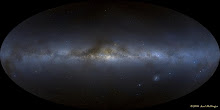 An impression of Stonehenge in Fermilab's 6,800 acre physics park, Batavia Illinois. The 4 mile ring of the Tevatron collider with a 2 mile main injector ring is underground. If any collider can give us an idea of what to expect from the LHC, it is the Tevatron, first commissioned in 1983 and updated over the years. Run II started in March of 2001 with the new injector, but no major discoveries were made. The Tevatron as a proton-antiproton collider has been amped about as far as it can go and in 2009 or 2010, it will shut down. Another 200 staff out of 1900 are being laid off this spring. There will be no American replacement, though other projects at Fermilab in R&D and astrophysics will go on.
An impression of Stonehenge in Fermilab's 6,800 acre physics park, Batavia Illinois. The 4 mile ring of the Tevatron collider with a 2 mile main injector ring is underground. If any collider can give us an idea of what to expect from the LHC, it is the Tevatron, first commissioned in 1983 and updated over the years. Run II started in March of 2001 with the new injector, but no major discoveries were made. The Tevatron as a proton-antiproton collider has been amped about as far as it can go and in 2009 or 2010, it will shut down. Another 200 staff out of 1900 are being laid off this spring. There will be no American replacement, though other projects at Fermilab in R&D and astrophysics will go on.This is a surprising first for the USA. Instead of bigger and better, always at the leading edge in any field, the federal government has tossed its physicists into the LHC ring, about 700 of them with over $500 million as a cushion, actually a great deal. The Americans are the largest contingent at the LHC, about as many as the French and Italians combined. It might not be as fabulous as your own super expensive Super Collider in Texas, scrapped after $2 billion to dig most of the ring, but Congress wasn't convinced that the project had any real benefits. It now has, if the rumor is true, that mushroom growers have moved in.
And so the Tevatron will live on in spirit at the LHC. Since the days of the LEP collider at CERN, there's been a close collaboration going on with Fermilab. Much of the LHC design was pioneered at the Tevatron and many of Fermilab's physicists and engineers have already found jobs, noteably at the CMS, and other LHC experiments. This is a terrific bonus for CERN. Through its long history the Tevatron has been frought with problems, including at least 2 major accidents, both involving a beam loss in 2003. Hopefully they've been designed out at the LHC, but the Americans will have the know-how just in case.
The Tevatron has also made several key discoveries in particle physics and confirmed some of CERN's work on producing antihydrogen antimatter. In 1977 Fermilab detected the bottom quark, the top quark in 1995, and the tau neutrino in 2000. The Higgs has eluded them or maybe a few Higgs bosons are buried in all the messy data. But even though its days are numbered, the Tevatron is ramping up the search to 160 GeV. It's a matter of pride. Go out in a blaze of glory. Still the odds are way better with more juice at the LHC, 150 times more.
But success can also come packaged with errors and failures. Inevitable when you're working on something new, even on a variant of a focusing magnet you know well. Fermilab designed and built 16 huge superconducting magnets for the LHC, about $1 million each. With all their experience, a design error lead to failure of one inner triplet last March, 2007. During a 20 atmosphere pressure test, it exploded when its pipe support broke, releasing a cloud of helium coolant at the LHC. Luckily no one was nearby. The damaged triplet was replaced and the others modified, adding more costs and delays.
 Cointrin
Cointrin

























No comments:
Post a Comment